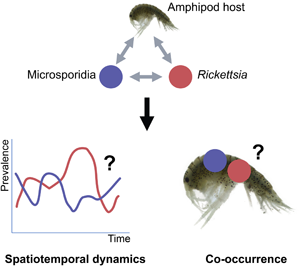Published online by Cambridge University Press: 24 May 2021

Biological interactions can greatly influence the abundance of species. This is also true for parasitic species that share the same host. Microsporidia and Rickettsia are widespread intracellular parasites in populations of Paracalliope fluviatilis, the most common freshwater amphipods in New Zealand. Although both parasites coexist in many populations, it is unclear whether they interact with each other. Here, we investigated spatial−temporal dynamics and co-occurrence of the two parasites, Microsporidia and Rickettsia in P. fluviatilis hosts, across one annual cycle and in three different locations. Prevalence of both Microsporidia and Rickettsia changed over time. However, while the prevalence of Rickettsia varied significantly between sampling times, that of Microsporidia did not change significantly and remained relatively low. The two parasites therefore followed different temporal patterns. Also, the prevalence of both parasites differed among locations, though the two species reached their highest prevalence in different locations. Lastly, there was no evidence for positive or negative associations between the two parasite species; the presence of one parasite in an individual host does not appear to influence the probability of infection by the other parasite. Their respective prevalence may follow different patterns among populations on a larger spatial scale due to environmental heterogeneity across locations.